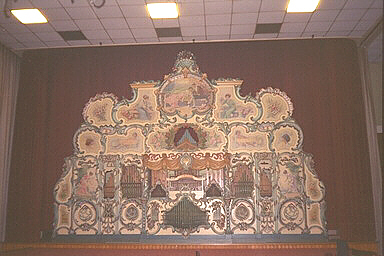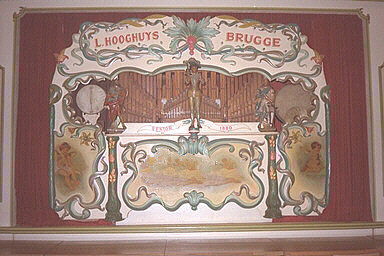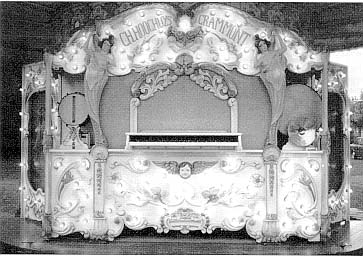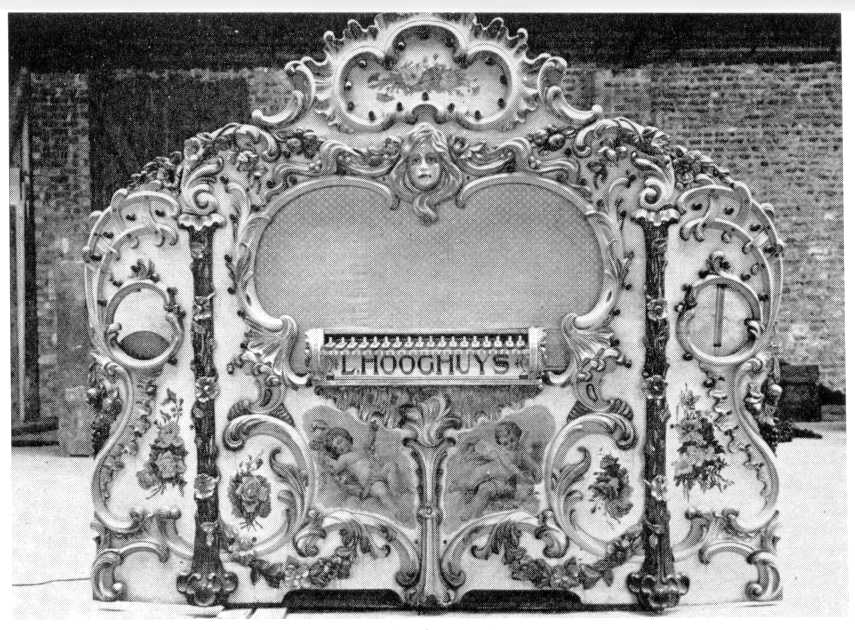| You Are Not Logged In | Login/Get New Account |
|
Please Log In. Accounts are free!
Logged In users are granted additional features including a more current version of the Archives and a simplified process for submitting articles. |
|
MMD
 Pictures
Pictures
 hooghuys
hooghuys
|
|
by Bjorn Isebaert (000112 MMD) Here's some pictures and information about Hooghuys organs in Belgium. It is possible that I forgot something to tell, but if I would write down everything I know about these organs, I could fill a whole MMDigest with it (and of course, there are a lot of other interesting subjects for the MMD) ... If anyone has some questions or more information, please e-mail me. Bjorn Isebaert
100-key Hooghuys dance organ "Condor"
This is a picture of a 100-key dance organ (LH605) built by Louis Hooghuys at Grammont (Geraardsbergen) in Belgium around 1910. The name "Brugge" (Bruges) has been painted now on the facade, because that's the place where the organ is to be found now, and it's also the place where the Hooghuys family started their activities as church organ-builders. This organ had 85 keys originally. It was built for a certain Mr. Beauprez, who owned a dance-hall ("The Sunflower") in Ostend, near the coast in Belgium. In 1919 it was sold to Mr. Versijp, who owned the dance hall "Eldorado" in Bruges. During WW2 the organ was stored in a garage at Ypres, where it was found in the early 1950s by the grandson of Louis, Romain-Charles Hooghuys (after some information he got from Jean-Baptiste Rorive, the owner of some magnificent other Hooghuys organs in Belgium). Romain-Charles bought the organ for a very low price (at that time). Actually, the organ was in a pretty good condition, although some parts had to be restored. At the same time of this restoration, the scale was slightly changed and extended to 100 keys. Originally, the organ had a guitar (in front of the flute harmonique), but probably because this mechanism gets unvoiced quite fast, and also because it doesn't sound loud enough, this was removed (as in most of the other Hooghuys dance organs). The organ in the museum of Utrecht (NL) still has a mandoline mechanism, but it isn't connected. A LP record was released in the late 1960s but (for those who own the LP) the picture on the cover is not of the Condor, but of an organ with a very similar facade and with 93-keys: LH600 - one of the organs with a Gavioli-based-scale built by Louis Hooghuys which was dismantled by Romain-Charles. The LP record was released again in the early 1970s but then the black-and-white picture of the previous release had been coloured (rather badly, I think). In the late 1970s the organ was hired by Mr. Daniel Dagraed, who owned an organ-museum at Bruges (the only one we ever had, and it was sold to Switzerland and Japan in 1989, I believe), but very soon, he replaced it by a Mortier organ. Then finally, the Condor organ found a place in the restaurant of a theme park in Bruges ("Het Boudewijnpark"), where it still can be heard today (only on request and if there is no party going on, of course). Some additional information: - the scale is as follows: 8 basses and bombardon
melody: 24 keys: violin, flute harmonique, xylophone, octave-flute, clarinets, vox celesta, oboe and musettina (which replaced the original accordeon-register) counter-melody: 19 keys: celli, bass-flute, bourdon, celesta and vox humana (with tremolo on register) 12 piccolo's, added later, when the scale was extended to 100 keys percussion: big drum with cymbal, side drum, castanets, wood block, piano-cymbal (for rhythmic accents) and triangle - the organ facade is about 5-1/2 metres long and 4 metres high - the repertoire has some very famous titles, such as the Radetzky march, the Tritsch-tratsch-polka and the Blaze Away march, but there are also two original compositions by Romain-Charles Hooghuys. He arranged all the music for the organ, about 25 books -- not too much, unfortunately -- except for some old books by Edgard Hooghuys and August Schollaert, namely the Tango del Mamita and an old schottisch ("Souvenir"); a rather rare arrangement is the Ave Maria of Bach/Gounod (not in the waltz-tempo): it is one of my favourites. - where the name "Condor" comes from, I don't know ... - the organ (and also the next two organs) is now kept in good condition by Marc Hooghuys, the son of Romain-Charles.
72-key Hooghuys fair organ "Senior"
This is a 72-key fair organ, which is also to be found in Het Boudewijnpark, where the Condor is also. (Actually, the theme park bought the organ, but unfortunately, they don't play it that much.) As far as we know, the organ was built around 1895/7 by Louis Hooghuys for someone from Menen. Then it was bought by Mr. Demeyere from Kortrijk in 1906. It is said that Mr. Demeyere had the organ converted to a book-playing organ, so the organ would have been originally a barrel organ, but I have reasons to doubt this (cf. infra). During WW1 it was stored at Lille in France, where it was bought in 1919 by Mr. Bossier, who hired out organs. Finally, it was bought by Romain-Charles Hooghuys who used it until the late 1970's on the streets of Bruges. Then he placed it in Het Boudewijnpark. (Romain-Charles Hooghuys died at the age of 89 in 1989 in a car accident.) The organ disposition has been modified a lot actually, and so the very first row of pipes in the centre of the organ contain some German orchestrion pipes. As normal with Hooghuys organs, it has only 8 basses (although there are some Hooghuys-organs with only 6 basses); this can be explained by the fact that Louis Hooghuys was very conservative (unlike, e.g., Mortier). The scale is the same as that of the 72-key organ of Mr. Vroman (see the text on his dance organ), therefore the books can be exchanged (although the organ of Mr. Vroman misses the oboe register). The Senior has the serial number 520, the organ of Mr. Vroman 522, so they must have been built together or at least with not too much time between. This is one of the reasons why I doubt the Senior was originally a barrel organ, because there is no evidence that the organ of Mr. Vroman was originally a barrel organ (moreover, there are no more tracks of the setting of the barrel in the inside of the organ-case). In the late 1960's and early 1970's, three LP records were released of the organ. (A fourth record was made, but it was never released; only two copies of it are extant). The repertoire is very unusual (all books arranged by Romain-Charles Hooghuys): it mainly consists of local songs, with some more popular titles (such as Drink, drink and Que sera, sera). The only long book is Les patineurs from Waldteufel. The organ doesn't have a tremolo-register, but as some of you might know, one of the main characteristics of Hooghuys organs is the ability to repeat a note very quickly -- no other organs can do it that accurately, that's for sure! Well, Romain-Charles Hooghuys has used this possibility quite a lot in his arrangements. (Actually, rather too much: in some arrangements, the melody is completely cut in tremolo-effect !). The facade of this organ is not the original one: it is the one of the organ of Mr. Vroman (although the side wings are missing; the top of the facade is owned by Mr. Vroman). It's not known where the original facade has gone. Also, the origin of the name "Senior" for the organ is unknown.
72-key Hooghuys dance hall organ
This is also a 72-key Hooghuys organ, but it is a dance organ instead of a fair organ. Nevertheless, it is to be found in a "Carrousel galopant", owned by Norbert Vroman of Lendelede (Belgium). Although the facade mentions "Ch(arles) Hooghuys", the organ was built by Charles' father, Louis; the name was probably changed because Charles was responsible for the factory after Louis' death in 1924. (Although it's pretty sure that Charles Hooghuys didn't built any organs himself, but only modified and repaired Hooghuys and other organs. One of the organs in America is actually a German organ with a Hooghuys-keyframe in it.) The organ was bought by his father (Victor) from Albert Becquart, who owned the famous 70-key Hooghuys, but also owned and sold some other Hooghuys instruments. I believe the organ once has been in a velodrome ride, but that's not sure, because there probably have been two organs with the same facade (as can be seen on original photographs of the Hooghuys factory). Of course, as mentioned, the original facade is now in front of the Senior. The present facade of Mr. Vroman's organ was created by his father, who used some parts of an old 84-key Joseph Bursens dance organ. The cloth before the pipes is used to prevent the organ from sounding too loud. (It is only recently that there have been complaints: it has come so far that Mr. Vroman has had to place a fibreboard, with holes, behind the cloth. Boy, are they intolerant in Belgium or not ?!). Of course, since it was originally a dance organ, the cloth hasn't always been there (unlike on the 70-key fair organs of Mr. Becquart/Rorive). The repertoire is quite interesting: it contains original books by Louis Hooghuys (with polkas, mazurkas, waltzes, etc.), books by Charles Hooghuys, Edgard Hooghuys, Romain-Charles Hooghuys and Marc Hooghuys (e.g. the very rare Valse Louis XV). Also books by August Schollaert and Arthur Prinsen and some by Filip Neirynck, a quite good Belgian arranger. Of course, some titles are typical for Hooghuys organs: e.g. Versailles, Hooghuys-galop, Kusshandchen-waltz, Pyramides-march, For those who would be interested: no recordings of this organ have been made yet, although Mr. Vroman is planning to record a CD. (But don't think too much of it -- it could take another 5 years. Mr. Vroman also wants to get his organ in perfect condition before making a CD; since the organ is at the fair, it isn't always in perfect condition, although the organ is tuned every year and the most urgent repairs are carried out as soon as possible.) As mentioned, the organ doesn't have the oboe register (although some space has been provided), so there are only 71 keys. Mr. Vroman asked me to send his mailing address: N. Vroman-Ghesquiere
Bjorn Isebaert
70-key Hooghuys organ
This 70-key fairground organ was built around 1923 by Louis Hooghuys at Grammont (Geraardsbergen), Belgium. It has actually only three registers: piano, forte and carillon. It is one of the most famous organs built by Louis Hooghuys, and it once had the most beautiful sound I've ever heard. It was built for Albert Becquart (or his father), who traveled around Luxembourg and France, and occasionally in Belgium, with a set of gallopers -- a "caroussel galopant", as we call it here. Becquart has died a few years ago, I think; since the mid 1970s the gallopers and organ are owned by François Kopp. Quite a lot of recordings of this organ were made, especially on the Decca label. Almost every song recorded was the work of August Schollaert. It surprises me that no one of you has ever heard of him -- he Schollaert was, and still is, the most famous Belgian noteur of organ books. He died in 1958, but he was a very special musician, as I was told. He lived in Aalst, and conducted several orchestras and bands and arranged a lot of music. In fact, I don't think that there is any Hooghuys or Mortier organ for which he didn't arrange some music. Of course, a lot of his work has been lost. Actually, I'm trying to find his son, together with Marc Hooghuys, to find out what happened to all the types of organ books he made. About the records: As far as I know, about eight original records of the organ have been made; of course, later on, they brought them out again in a new sleeve or something like that. It began with 78-rpm records, and then 33-1/3-rpm microgrooves, with the title: "50 annees de succes". Then in the 1960s Becquart made some other LP's. As I wrote, all the arrangements were made by August Schollaert. Here is a small list of music I know was arranged by Schollaert and is featured on the Becquart organ: Blaze Away
Aimer Toujours
Since Mr. Kopp bought the organ it isn't the same anymore as it used to be. Recently, Norbert Vroman (who owns a set of gallopers with a 72-key Hooghuys organ) told me that Albert Becquart took care of the organ as if it was his own child -- he used to adjust the speed of the motor, and was quite mad when it didn't sound right. Actually, I never heard the organ live, but I certainly would like to, although I know that it would be a disillusion now. Kopp had made two LP's in the 1970's, which recently have been published on CD again. Here are some of the works on them. The star (*) means that I'm sure that the arrangement was made by Schollaert: Old faithful
Kaiser Friedrich
Ah, mon Dieu! I would like to tell you so much more about this organ, if only I had the time and more information. Unfortunately, we've lost track of the organ now, but we're sure to find it again. (The problem is that we don't know when and where Mr. Kopp is to be found.) I hope you are already a little satisfied by this, but I'm planning to write some more about it when I've some more time (since the exams are coming). Of course, I'm still looking for records of the Becquart organ. I have only the same one as mentioned in the Digest (with Blaze Away, Wiener Blut, The beautiful Galathea ...) and the three CD's, but the older records are much better! Thanks a lot, and write me back. Bjorn Isebaert
27 January 2000 |
|
|
|
|
|
|
|
|
|
CONTACT FORM: Click HERE to write to the editor, or to post a message about Mechanical Musical Instruments to the MMD Unless otherwise noted, all opinions are those of the individual authors and may not represent those of the editors. Compilation copyright 1995-2026 by Jody Kravitz. Please read our Republication Policy before copying information from or creating links to this web site. Click HERE to contact the webmaster regarding problems with the website. |
|
|
||||||
|



